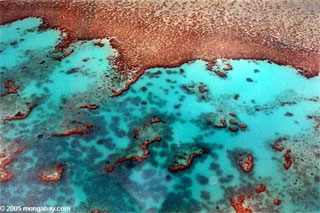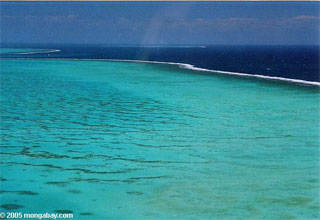Protecting coral reefs and mangrove forests makes economic sense according to a new report by the United Nations Environment Programme (UNEP). The report, titled “In the Front Line: Shoreline Protection and other Ecosystem Services from Mangroves and Coral Reefs”, argues that conserving these ecosystems for the services they provide—from fisheries protection to erosion control to a source for medical compounds—is cost-effective relative to destroying them and substituting their role with man-made structures.
Reefs—more than pretty fish
UNEP estimates the value of coral reefs is between US$100,000 to US$600,000 per square kilometer a year while the cost of protecting them, through the management costs of a marine protected area, is just US$775 per square kilometer annually. Coral reefs help mitigate beach erosion, serve important functions for local fisheries, and have high recreation value for tourism. The report estimates that a typical coral reef can absorb up to 90 percent of the energy of wind-generated waves thus protecting coastal areas from damage. The report cites a study from Sri Lanka which shows that one square kilometer of coral reef prevents 2,000 cubic meters of coastal erosion annually.
In places where reefs have been damaged or destroyed the costs of erecting artificial barriers can be quite high. For example, following the degradation of the natural reef around the Male in the Maldives, the cost of installing artificial breakwaters made of concrete tetrapods was US$10 million per kilometer. In Indonesia, a hotel in West Lombok has spent an average of US$125,000 per year over seven years restoring its 250 meter-long beach following erosion that resulted from offshore coral mining.
 Great Barrier Reef in Australia |
The value of reefs in biodiverse regions can be even higher. In parts of Indonesia and the Caribbean where tourism is the main use, reefs are estimated to be worth US$1 million per square kilometer, based on the cost of maintaining sandy beaches and the value of attracting snorkelers and scuba divers. Meanwhile, a recent study of the Great Barrier Reef in Australia found that the reef is worth more to the country as an intact ecosystem than an extractive reserve for fishing. Each year more than 1.8 million tourists visit the reef, spending an estimated AU$4.3 billion (Australian dollars) on reef-related industries from diving to boat rental to posh island resort stays. In the Caribbean, says UNEP, the net annual benefits from diver tourism was US$2 billion in 2000 with US$625 million spent directly on diving on reefs. Further, reef tourism is important source of employment, especially for some of the world’s poorest people. UNEP says that of the estimated 30 million small-scale fishers in the developing world, most are dependent to a greater or lesser extent on coral reefs. In the Philippines, for example, more than one million small-scale fishers depend directly on coral reefs for their livelihoods.
The report estimates that reef fisheries were worth between $15,000 and $150,000 per square kilometer a year, while fish caught for aquariums were worth $500 a kilogram against $6 for fish caught as food. The aquarium fish export industry supports around 50,000 people and generates some US$5.5 million a year in Sri Lanka alone.
Mangroves—tsunami protection and key fish nursery
Mangrove forests—found in silt-rich, saline habitats worldwide, generally along large river deltas, estuaries, and coastal areas—are equally important ecosystems. These forests are critical spawning grounds and nurseries for marine and freshwater species, and also help prevent and reduce coastal erosion and storm damage, as seen in the aftermath of the 2004 tsunami in southeast Asia.
A study released in October 2005 showed that areas buffered by coastal forests, like mangroves, were less damaged by the 2004 tsunami than areas without tree vegetation. The study confirmed earlier experiments which have shown that 30 trees per 100 square meters may reduce the maximum flow of a tsunami by more than 90 percent. “In the Front Line” reached a similar conclusion.
“Mangroves dissipate the energy and size of waves as a result of the drag forces exerted by their multiple roots and stems,” says the report. “Wave energy may be reduced by 75 per cent in the wave’s passage through 200 meters of mangrove.”
The value of ecosystem services afforded by mangrove forests is estimated at over US$100,000 per square kilometer in American Samoa and US$3.5 million per square kilometer in Thailand. In Matang, Malaysia, a 400 square kilometer managed mangrove forest supports a fishery worth US$100 million a year. The Matang mangroves also generate further income providing forestry products worth US$10 million a year finds the report.
Threatened systems
 Great Barrier Reef in Australia
Marine reserves improve health of coral reefs finds study Dubai’s artificial islands have high environmental cost |
While coral reefs and mangrove forests provide critically important services, they are increasingly threatened ecosystems. Close to a third of coral reefs are gone and scientists estimate that 60 percent may to be lost by 2030. Similarly, more than a third of all mangroves have disappeared—20% since 1980. Some scientists are concerned that global climate change could drastically effect these ecosystems since they exist in areas that will be most affected by changing sea levels and warmer oceans.
A report issued in 2004 warned that a 1.5 degrees Celsius rise in ocean temperatures could cause 95% of the corals on Australia’s Great Barrier Reef to die by 2050 while increasing ocean acidity could doom some of the ocean’s smallest organisms which form the base of the marine food chain.
Assessing the costs
Scientists have teamed with the UN to try to better understand the effects of these changes fate by valuing the world’s ecosystems. Through the Millennium Ecosystem Assessment, over 1400 experts in various scientific fields from 95 countries around the world are working to determine how changes to the environment affect humans. Thus far, the research has found that 0.5 percent of the area of natural terrestrial habitats is lost each year, at a great economic cost.
Klaus Toepfer, UNEP’s Executive Director, hopes that by assigning dollars amounts to ecosystems such as coral reefs and mangrove forests, people will be better able to recognize the value of nature’s services.
“I hope the financial facts contained in this study will radically change the attitude and behaviour of governments, industry, local authorities and individuals, so that they better prize and conserve these natural assets. So that they think twice about the pollution, climate change, insensitive development and other damaging practices that are rapidly undermining the economic basis for so many coastal communities world-wide,” said Toepfer.